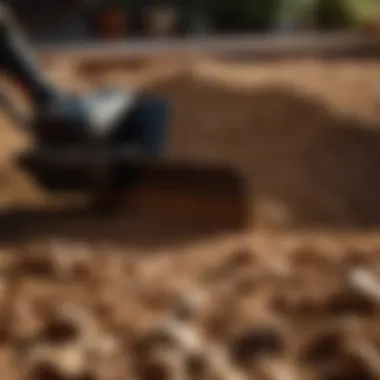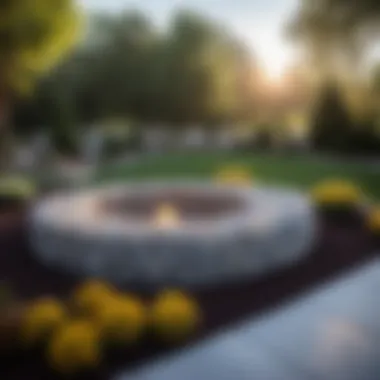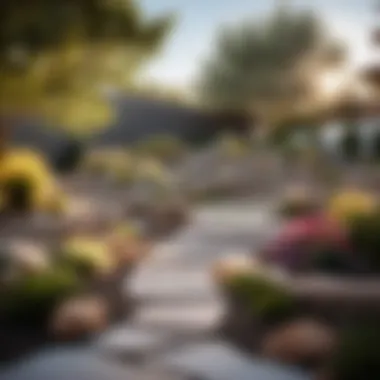Materials:
- Type of Rock: River rock, crushed stone, pea gravel
- Quantity: Calculate based on square footage for adequate coverage
- Weed Barrier Fabric: To prevent weed growth
- Landscape Edging: For defining borders
- Shovel: For digging and leveling
- Rake: To spread and even out the rock
DIY Steps:
-
Planning: Measure the yard area and determine the amount of rock needed. Select the type of rock based on aesthetic preference and function.
-
Preparation: Clear the area of any debris or vegetation. Install weed barrier fabric to prevent weed growth through the rock.
-
Installation: Begin by spreading a layer of rock evenly across the prepared area. Use a shovel to distribute the rock and a rake to level it out for consistency.
Technical Aspects:
- Timing: Choose a time when the weather is dry to ease installation.
- Tools: Ensure you have a shovel, rake, and gloves for safety.
- Critical Techniques: Level the ground before laying the weed barrier fabric for a smooth surface.
DIY project Process:


-
Ground Preparation: Clear the area of any debris and rocks. Level the ground for a uniform base.
-
Weed Barrier Installation: Lay the weed barrier fabric over the prepared ground to inhibit weed growth.
-
Rock Placement: Spread the chosen rock type evenly over the fabric. Use a shovel to distribute and a rake to level out the surface.
Troubleshooting Tips:


- Weeds: Regularly inspect and remove any stray weeds that may grow through the rock layer.
- Uneven Surface: Use a rake to smooth out any uneven areas for a polished finish.
From selecting the right rock type to executing a seamless installation process, this guide equips you with the knowledge and tools needed to transform your yard into a stunning outdoor space.
Introduction


To embark on the journey of rock landscaping is to embrace a versatile and durable solution for adding character and visual interest to your property. Whether you are seeking to reduce lawn maintenance, create distinct focal points, or redefine the overall ambiance of your exterior space, the strategic integration of various types of landscaping rocks can serve as a game-changer.
As we navigate through the different aspects of laying down rocks in your yard, we will uncover the nuances of rock selection, ground preparation, installation techniques, and maintenance strategies. By the time you reach the conclusion of this guide, you will be equipped with the knowledge and insight necessary to initiate and complete a rock landscaping project that seamlessly blends creativity with practicality. Prepare to explore the intricate world of rock landscaping and discover how this ancient practice can breathe new life into your outdoor sanctuary.
Let's venture into the realm where nature's elegance meets human ingenuity, as we unravel the various facets of enhancing your yard with the unparalleled allure of rocks.
Benefits of Rock Landscaping
Rock landscaping offers numerous benefits that can transform your yard into a stunning and functional outdoor space. One of the key advantages is the low maintenance required once the rocks are in place. Unlike traditional grass or flower beds, rock landscaping minimizes the need for watering, mowing, and fertilizing, saving you time and effort in the long run. Additionally, rocks provide excellent drainage, preventing water buildup that can lead to issues like flooding or soil erosion.
Another significant benefit of rock landscaping is its durability and longevity. Rocks are highly resilient to harsh weather conditions, ensuring that your yard maintains its beauty year-round with minimal wear and tear. They also act as a natural weed barrier, reducing the need for chemicals or constant weeding. Moreover, rocks come in a variety of sizes, shapes, and colors, allowing you to customize your landscape design according to your preferences and style.
When considering the benefits of rock landscaping, it's essential to factor in its cost-effectiveness. While initial installation may require some investment, the long-term savings on maintenance and replacement make rock landscaping a cost-efficient choice for homeowners. Additionally, rocks can enhance the aesthetic appeal of your yard, adding a touch of sophistication and uniqueness to your outdoor space.
In summary, rock landscaping stands out as a practical, durable, cost-effective, and aesthetically pleasing option for homeowners looking to elevate their yard's design. By harnessing the benefits of rock landscaping, you can create a picturesque landscape that requires minimal upkeep while enhancing the overall charm and functionality of your outdoor living area.
Choosing the Right Type of Rock
Selecting the appropriate rock for your landscaping project is a critical decision that can significantly impact the aesthetic and functional aspects of your yard. In this section, we will delve into the crucial considerations and benefits associated with choosing the right type of rock to ensure a successful and visually appealing outcome.
Considerations for Rock Selection
When determining the ideal rock for your yard, several factors come into play. It's essential to assess the color, size, texture, and overall compatibility of the rock with your existing landscape design. Moreover, considering the maintenance requirements and durability of the rock is pivotal in making a lasting choice that aligns with your desired outcome.
Popular Types of Landscaping Rocks
River Rock
River rock stands out for its smooth, rounded edges and natural color variations, making it a popular choice in landscaping projects. Its versatility allows for various design possibilities, adding a serene and organic touch to outdoor spaces. With its ability to regulate soil temperature and deter weed growth, river rock proves to be not only aesthetically pleasing but also functional.
Pebbles
Pebbles offer a charming and whimsical appeal to yards, with their small, smooth stones available in an array of colors. Ideal for creating pathways or accentuating flower beds, pebbles are low-maintenance and environmentally friendly. Their drainage properties make them an excellent choice for enhancing the overall look of your garden.
Crushed Gravel
Crushed gravel, known for its angular shape and varied sizes, is a durable and cost-effective option for landscaping projects. Its porous nature facilitates water drainage, preventing erosion and water accumulation. This type of rock is perfect for driveways, walkways, and drainage solutions, adding a rustic and textured element to outdoor areas.
Lava Rock
Distinctive for its lightweight and porous structure, lava rock is a striking choice that aids in moisture retention and weed prevention. Its unique appearance adds a bold contrast to greenery, offering a touch of drama to garden spaces. While lava rock requires minimal maintenance, its dark coloration can contribute to heat absorption, making it essential to consider the climate and placement when utilizing it in landscaping.
Preparing the Ground
In the process of laying down rock in your yard, preparing the ground is a crucial step that sets the foundation for a successful landscaping project. This section delves into the significance of preparing the ground in this comprehensive guide to creating a visually appealing and functional outdoor space. To ensure the longevity and stability of the rock installation, thorough preparation of the ground is essential.
Clearing the Area
Clearing the area is the first task in the ground preparation stage. It involves removing any existing vegetation, debris, rocks, or obstacles from the designated area where the rocks will be laid. By clearing the area, you create a clean canvas for the rock installation, minimizing the risk of uneven surfaces or potential damage to the rocks over time. Ensuring the ground is free of any unwanted elements also facilitates better drainage and prevents the growth of weeds underneath the rock layer.
Leveling the Ground
Leveling the ground is a fundamental step in creating a uniform and visually pleasing rock landscape. This process involves smoothing out any bumps, holes, or uneven spots in the area where the rocks will be placed. Utilizing appropriate tools such as a rake or a shovel, you can achieve a flat and consistent surface that will enhance the aesthetic appeal of your yard. Properly leveled ground also promotes better water drainage and prevents the accumulation of water in certain areas, which could affect the longevity of the rock installation.
Installing Weed Barrier
Installing a weed barrier is an essential aspect of ground preparation to prevent weed growth and ensure the low-maintenance aspect of your rock landscape. The weed barrier acts as a protective layer between the ground and the rocks, inhibiting weed seeds from germinating and penetrating through the rock layer. This step not only reduces the need for constant weeding but also helps in maintaining the neat appearance of your yard. Select a high-quality weed barrier fabric that is permeable to allow for proper water drainage while effectively suppressing weed growth.
Laying Down Rock
Spreading the Rocks
Spreading the rocks is a fundamental step in the rock landscaping process. It involves evenly distributing the chosen rocks across the designated area to create a uniform and aesthetically pleasing coverage. Begin by dumping a moderate amount of rocks onto the cleared and leveled ground. Then, using a rake or shovel, carefully disperse the rocks, ensuring they are spread out evenly without clumps or gaps. Pay attention to the thickness of the rock layer, aiming for a consistent depth throughout the space for a polished look.
Creating Patterns or Designs
The creative aspect of laying down rock lies in the opportunity to design patterns that enhance your outdoor space's visual appeal. Whether you opt for a symmetrical arrangement, random scatter, or intricate patterns, the key is to plan the design beforehand. Consider factors like color contrast, rock size variation, and the overall landscape theme. Experiment with different layouts before committing to a final design, visualizing how the patterns will complement existing features or vegetation in your yard.
Securing the Rocks
Securing the rocks is essential to prevent displacement and maintain the design integrity of your rock landscaping. Depending on the rock type and your preference, there are various methods to secure the rocks in place. Utilize landscape fabric or geotextile underlay to help anchor the rocks and minimize shifting. In areas prone to erosion or heavy foot traffic, you may consider using edging materials like metal, plastic, or stone borders to contain the rock arrangement. Additionally, strategically places larger rocks or boulders can act as natural barriers and anchors within the layout, enhancing stability and visual interest.
Maintenance Tips
Maintenance is a crucial aspect to consider once you have laid down rock in your yard. To ensure your landscaping remains pristine and visually appealing, incorporating regular maintenance practices is essential. One significant element of maintenance to focus on is weed control. Weeds can quickly invade the area between rocks, detracting from the overall look and requiring tedious removal if left unchecked. By implementing effective weed control measures, such as using weed barriers during installation and applying pre-emergent herbicides, you can significantly reduce weed growth and minimize the need for manual weed removal.
Another vital maintenance tip is regular cleaning and raking of the rock beds. Over time, debris, leaves, and other organic matter can accumulate on the surface, diminishing the aesthetic appeal of the landscaping. By regularly raking and removing debris, you can preserve the neat and well-maintained appearance of your rock bed. Additionally, periodic cleaning with a pressure washer or garden hose can help prevent the buildup of dirt and grime, ensuring your rock landscaping stays fresh and vibrant.
Conclusion
One of the primary aspects to consider in the Conclusion phase is ensuring that all the detailed steps outlined in earlier sections have been implemented with precision. This includes verifying that the chosen type of rock aligns with the overall aesthetics of your yard while also taking into account practical considerations such as drainage, maintenance, and longevity.
Moreover, the Conclusion segment is where you get to step back and admire the fruits of your labor. It is a moment of satisfaction and fulfillment as you witness how the carefully placed rocks have enhanced the beauty of your outdoor space, creating visual interest and texture that elevates the entire ambience of your yard.
Another crucial point to emphasize in the Conclusion is the importance of ongoing maintenance to ensure the longevity and sustainability of your rock landscaping. From regular weeding to periodic cleaning and re-leveling, proper upkeep is key to preserving the immaculate appearance of your rock features over time.
In summary, the Conclusion section of this comprehensive guide encapsulates the essence of completing a successful rock landscaping project. It symbolizes the transformation of a simple yard into a harmonious blend of natural beauty and human design, inviting you to sit back, relax, and appreciate the peaceful retreat you've created right at your doorstep.





